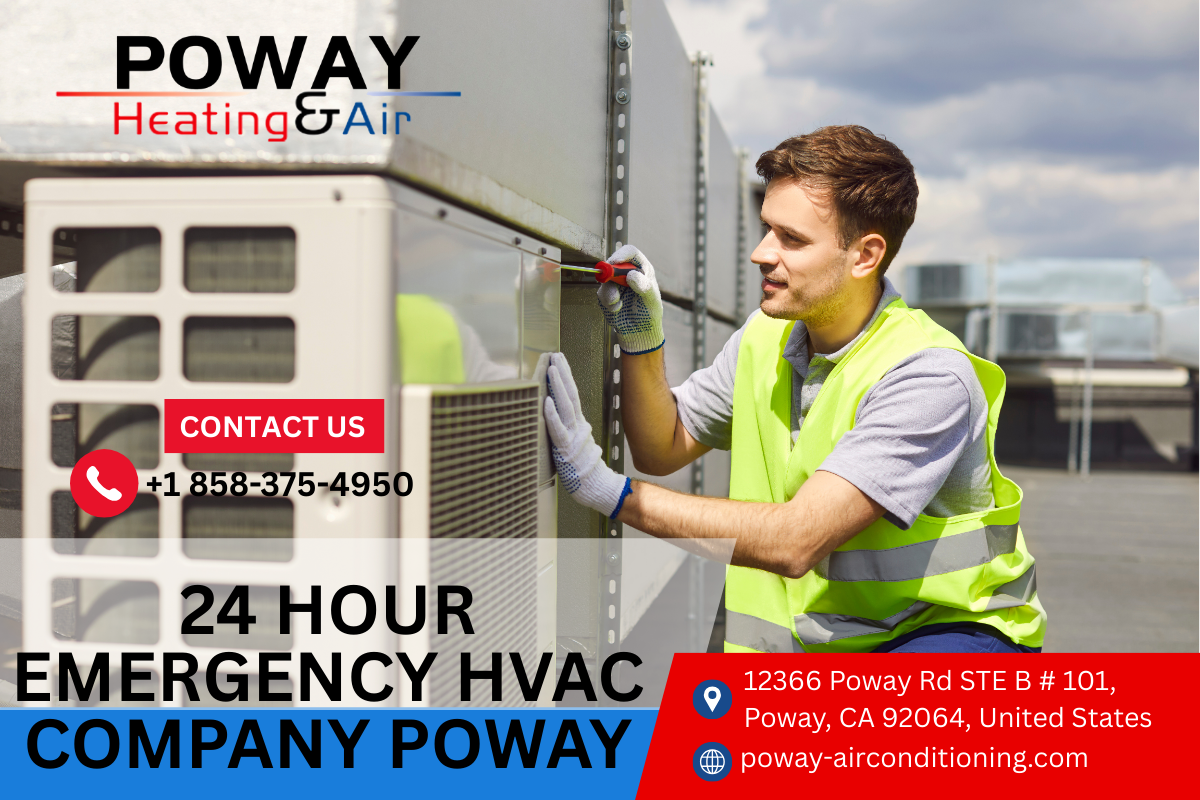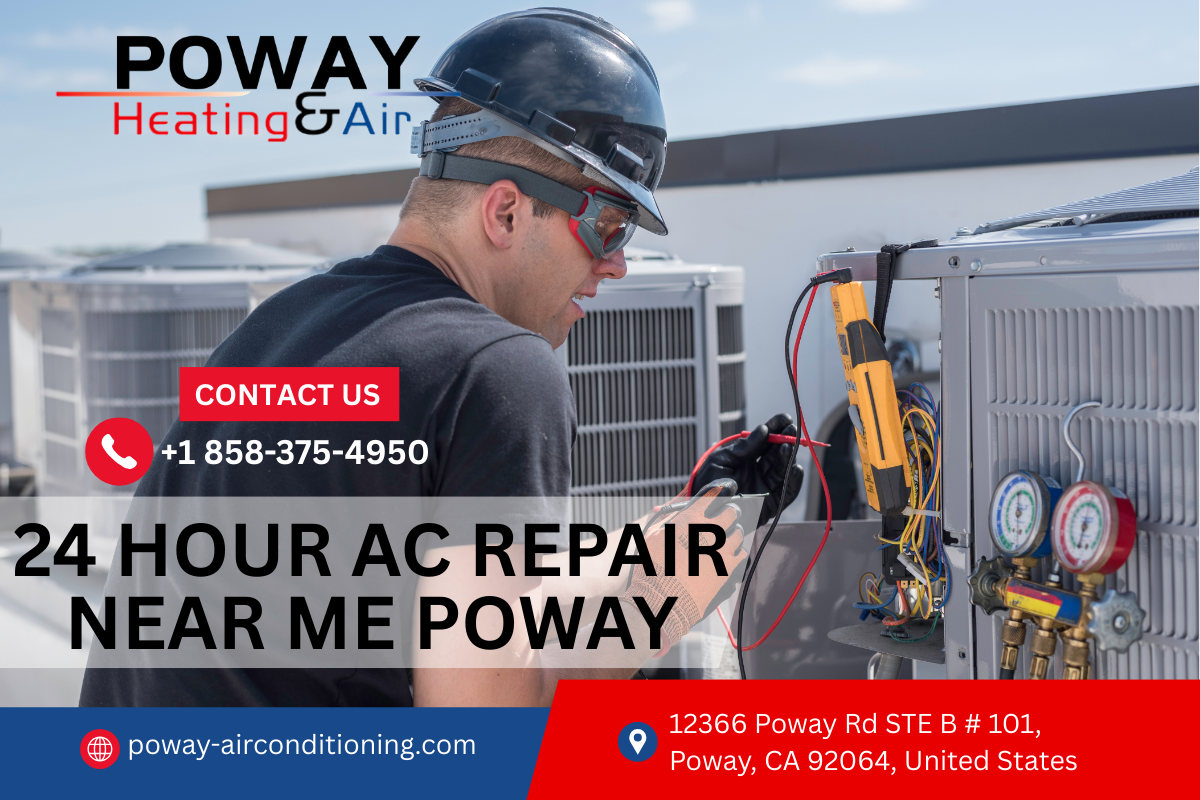


When your air conditioner quits during a Santa Ana heat burst or your furnace fails on a damp December night, you do not need a lecture on preventative maintenance. You need a fast, capable technician who can diagnose the problem, stabilize the system, and keep your home livable. In Poway, with its hot, dry summers and cool coastal evenings, a reliable emergency HVAC company is less a luxury and more a lifeline. The trick is separating true emergency service from voicemail promises and next-week scheduling.
This guide draws on field experience, the realities of local housing stock, and patterns technicians see in 24 hour emergency calls. The goal is to help Poway homeowners make good decisions before and during a crisis, and to recognize when emergency hvac services Poway can save a system from serious damage.
What makes an HVAC issue an emergency in Poway
Not every AC hiccup merits a midnight dispatch. Yet waiting can turn a manageable fault into a compressor failure or a flooded ceiling. In this climate, the stakes are more than comfort. A home with pets, infants, or elders can become unsafe quickly once indoor temperatures climb above the mid 80s. Heat-sensitive medications and electronics also complicate the decision.
From a technician’s perspective, an emergency AC repair in Poway is warranted when there is active water damage from a clogged condensate line, an electrical burning smell, a system repeatedly tripping the breaker, a heat pump or furnace cycling but producing no conditioned air during a temperature extreme, or a refrigerant line frosting over with the evaporator coil icing. Those conditions can cascade into bigger repairs if left overnight.
I have seen a small, benign condensate drip become a ceiling repair costing several thousand dollars because the unit sat above a hallway and the leak migrated along a joist. A 20 minute vacuum of the drain line and float switch reset could have stopped it. Likewise, a compressor that overheats after a fan motor stalls can fail in hours. That is not hyperbole, it is the physics of oil breakdown and thermal stress.
Why Poway’s climate and housing stock matter
Poway sits inland enough to get real heat, with July and August afternoons routinely in the 90s and heat waves spiking past 100. Relative humidity usually runs low, especially during Santa Anas, which is good for evaporative cooling but hard on ductwork and seals that dry out. Many homes are single story ranch styles from the 70s through early 2000s, with systems tucked in attics or side yards. That means long duct runs, radiant attic heat, and packaged or split systems exposed to full sun. All of that shapes failure modes.
Attic air handlers in this area often struggle with airflow when filters clog, and heat-soaked attics push blower motors past their thermal limits on peak days. Outdoor condensing units bake on south and west exposures. UV and heat accelerate capacitor failure, brittle wire insulation, and contactor pitting. If you only call when it fails at 5 pm on a 98 degree day, know that the system has been working harder than usual, and the odds of secondary failures rise each hour.
The first five minutes when the system stops
Before you call an emergency hvac company Poway residents trust, a few quick checks can save time and reduce your bill. Safety first: if you smell burning or see smoke, cut power at the disconnect or breaker and step away. If not, run through a simple triage. These are not fixes, just fast, safe observations that help the dispatcher and technician land on the right truck with the right parts.
- Confirm the thermostat has power, is set to Cool or Heat as needed, and the setpoint is sensible. Replace batteries if it is a battery thermostat. Check the circuit breaker for the air handler and condenser. A tripped breaker hints at an electrical fault, so if it trips again immediately, stop and call. Inspect the filter. If it is clogged, replace it and let the system rest 20 minutes before trying again. Look at the outdoor unit fan. If the compressor hums but the fan does not spin, shut it down. A failed capacitor or motor may be at play. Running it can cook the compressor. Check for water at the indoor unit. A wet safety switch or full pan points to a drainage issue. Power down and call for emergency AC repair Poway to prevent further water damage.
Share what you see. Clear, specific symptoms over the phone often shave 30 to 60 minutes off diagnostic time. A good dispatcher will ask these questions anyway.
What a true emergency HVAC repair service in Poway looks like
Not all “24 hour ac repair near me” search results lead to teams that roll at 10 pm. Some companies take after-hours calls then schedule the next morning. That is fine for shoulder seasons, not for a family stuck in extreme heat. A genuine 24 hour emergency hvac company will answer live or call back within minutes, commit to a window, and explain any after-hours diagnostic fees. They will arrive in a stocked truck, not a sedan with a toolbag.
Look for NATE or state-certified technicians, proof of license and liability insurance, and vans carrying common Poway parts: dual-run capacitors sized for popular condenser models, 40/5 and 45/5 are common; contactors; universal fan motors; 24V transformers; condensate pumps and PVC for drain repairs; refrigerant, both R-410A and, in older systems, R-22 substitute options. When a tech carries these, same day air conditioner repair is realistic rather than hopeful.
Strong emergency teams communicate before arrival, give a brief plan on arrival, and, crucially, stabilize the system fast. By stabilize I mean arrest water leaks, make electrical faults safe, get airflow restored, and cool or heat the home enough to relieve stress, then explain options calmly.
Common emergency calls in Poway and what they signal
Every city has patterns. These show up repeatedly in Poway, especially on hot runs and first cold snaps.
Capacitor failures on hot afternoons. The outdoor fan stalls or the compressor tries to start with a groan. The unit may buzz. Heat deteriorates capacitors, and a failing component can take the compressor with it. The fix is straightforward when addressed quickly. A tech will test microfarads under load, replace if out of tolerance, and inspect the contactor for arcing.
Clogged condensate drains on attic units. A small algae bloom or debris in https://andresdpmf519.timeforchangecounselling.com/same-day-air-conditioner-repair-poway-s-speedy-cooling-solutions the trap trips the float switch, shutting cooling to prevent overflow, or worse, fails to trip and leaks. Good emergency hvac repair service Poway teams carry pressurized nitrogen or wet vacs to clear lines, plus tablets to slow algae growth. They also check trap design. Some older installs lack a cleanout or have traps too shallow for negative pressure.
Iced evaporator coils during heat waves. Reduced airflow from a dirty filter or undersized ductwork can freeze the coil. Homeowners often see frost on the suction line and think more refrigerant is needed. Often it is airflow. The immediate step is to power down the cooling, run the fan to thaw the coil, and correct airflow. A reputable tech will not add refrigerant without confirming a leak, and will measure superheat and subcool to prove the charge.
Short cycling furnaces on first cold nights. Blower housings that have collected summer dust, flame sensors with oxidation, and pressure switches with weak tubing conspire to shut burners after ignition. It feels like a big failure. It is often a 60 to 90 minute cleaning and test with proper combustion checks.
Breaker trips during startup. Compressors under heavy head pressure after short cycling can pull large inrush current. Sometimes a hard-start kit is appropriate. Other times the cause is a failing compressor. An experienced emergency hvac company Poway homeowners call regularly will evaluate the compressor’s health with an insulation resistance test and winding check before throwing parts at it.
What to expect on price and scope after hours
After-hours diagnostics typically carry a premium. In this region, emergency dispatch fees often fall in the 150 to 250 range above normal diagnostic charges, sometimes higher during holidays. Parts pricing can be similar to daytime pricing, though some companies add a modest premium for late-night parts pulled from inventory. Good companies disclose these fees up front. If a tech refuses to give a range, push for clarity.
The goal during an emergency visit is to restore operation and prevent damage. Full load calculations, duct redesigns, or seasonal tune-up elements can wait for daylight. If a major part fails, like a compressor or control board that is not on the truck, a qualified tech will offer a safe temporary approach where possible. For example, bypassing a faulty condensate safety switch temporarily is not safe and should not be proposed. Installing a temporary condensate pump to prevent overflow, with a follow-up to redo the drain properly, can be reasonable. The line between prudent and risky temporary fixes is where experience shows. Ask, “Is this safe overnight, and what are the risks if we wait until morning?” Then get that answer in writing on the ticket.
How dispatch prioritizes during heat waves
When calls flood in, dispatchers triage. Elderly occupants, medical needs, and indoor temperatures above 85 often move to the front. Water damage and electrical burning smells also jump the line. Good dispatchers ask about pets, infants, or medical equipment that requires climate control.
Be concise and honest. I have seen homeowners who underplayed a leak wait behind five calls, then end up with drywall damage that could have been avoided. Share your symptoms clearly, ask if photos or a short video would help, and make it easy to find your home after dark with visible house numbers and a porch light. Those little steps trim minutes that matter.
The difference between a quick fix and a lasting repair
A system limping in 110 degree attic conditions might accept a new capacitor and run, only to fail again a week later if a pitted contactor or failing fan motor sits untouched. Competent emergency ac repair includes a holistic look: test voltage drop across contactors, measure motor amps versus nameplate, verify coil cleanliness, and confirm refrigerant pressures and temperatures reflect a healthy system. That does not mean replacing parts that still test fine. It means identifying components clearly on the edge.
There is an art to telling a homeowner, “This will run tonight, but this motor is pulling 10 to 20 percent above its rating. You might get a month, you might get a day.” That honesty is the mark of a trustworthy emergency hvac company.
Refrigerant realities, especially in older systems
Poway still has plenty of R-22 systems hanging on. With R-22 phased out, any refrigerant addition becomes a decision point. If a leak is small and the system is otherwise sound, a top-off using an EPA-compliant substitute or reclaimed R-22 can buy time. If the leak is significant, continued topping off becomes an expensive bandage. A solid emergency hvac repair service Poway tech will pressure test, use electronic detection, and discuss whether a leak search is worth it based on system age and efficiency. Expect a conversation about SEER ratings and payback. It should be a conversation, not a sales pitch at midnight.
Safety notes that too often get ignored
A few hazards repeat across emergency calls. Combustion safety around gas furnaces matters. If you smell gas, do not try to relight anything. Venting and carbon monoxide concerns are real with older equipment, especially after roof work or seismic activity that shifts flues. Electrical isolation matters with condensers. Homeowners sometimes reset breakers repeatedly on a tripping unit. Each reset stresses components and can turn a repairable fault into a catastrophic failure.
Water around air handlers poses shock risk. Attic walk boards are not always adequate. Do not climb into a baking attic at 9 pm unless you have the right lights and a clear path. Emergency techs carry headlamps, cordless vacs, pumps, and a healthy respect for roofing nails sticking down through decking.
Preventative moves that help in the next emergency
It is easy to promise preventative maintenance once the house cools again. A few specific practices actually move the needle in Poway:
- Replace filters on a schedule, not by eye. High-MERV filters can choke airflow in older systems. If you use MERV 11 or higher, shorten the interval and consider a media cabinet upgrade to increase surface area. Keep the outdoor unit clear of sun-baked debris. Landscaping gravel, palm fronds, and dust accumulate on coils. A gentle rinse with a garden hose from the inside out, power off, once or twice a season helps. Avoid harsh pressure that folds fins. Flush condensate lines at the start of summer. A quarter cup of white vinegar followed by water helps limit algae growth. Ask your technician to install a cleanout tee if you do not have one. Shade and airflow matter. A simple shade sail that preserves at least two feet of clearance can cut condenser temps. Do not box units in with lattice. Give your thermostat a sanity check before the first heat wave. Run cooling for 10 minutes in spring to see if anything sounds or smells off. Early discovery means same day air conditioner repair without emergency fees.
When replacement trumps repair during an emergency
No one wants to discuss a system changeout at 11 pm. Sometimes it is the right move. If a compressor is grounded and the system is over 12 to 15 years old, pouring money into major components rarely pencils out. Efficiency gains from a modern heat pump or high-SEER AC can be dramatic in Poway’s climate, especially if you address duct leakage. That said, a well-run emergency visit should stabilize your home, propose options, and schedule a daytime visit with a comfort advisor for a proper load calculation. Beware techs who force a decision in the driveway under a flashlight. You may decide on a replacement, but you should not be rushed into a wrong-sized unit because it is what they had on the truck.
Finding a dependable emergency HVAC company Poway can rely on
Reputation matters most when phones are ringing off the hook. Look for consistent reviews that praise communication and follow-up, not just speed. Ask neighbors how the company handled warranty parts and callbacks. Confirm the company maintains true 24 hour coverage, not just an answering service. A local warehouse or strong supplier relationships reduce delays. Technicians who live in or near Poway tend to know subdivision quirks like tight attic access in Heritage Hills or strict HOA access windows in certain communities.
I also value companies that document everything. Photos of failed parts, pressure readings, and a summary of work performed give you leverage if a related component fails soon after. It is the difference between “trust me” and “here is what we found.”
A realistic view of response times and what you can do meanwhile
Even the best emergency HVAC company cannot teleport. During peak heat, an hour or two is excellent, three to six hours is common. While you wait, close blinds, run ceiling fans counterclockwise to push air down, and avoid heat-generating appliances. If you have a whole-house fan, use it after sunset when outside temps drop, not during peak heat. For heating failures on cold nights, bundle rooms, use safe space heaters on dedicated circuits away from bedding, and crack a window if using a gas fireplace to ensure ventilation. Pet comfort matters. Move kennels to the coolest part of the house and offer extra water.
Technicians appreciate a clear path to the equipment, pets secured, and a quick recap of symptoms. It sounds trivial. It saves minutes every visit.
The value of same day air conditioner repair without crisis pricing
The best outcome is avoiding the emergency call altogether. Many companies in Poway offer same day air conditioner repair during business hours when you call early. If you hear intermittent noises, notice reduced airflow, or see occasional water in the drain pan, calling at 9 am usually avoids after-hours fees and the stress of a hot house. Dispatchers can steer techs with the right parts, and you are more likely to get a thorough tune-up along with the fix.
There is also a case for modest maintenance plans if they bring true value: priority scheduling during heat waves, discounted emergency fees, and two seasonal visits that include coil cleaning and static pressure checks. If a plan does not offer priority service or meaningful discounts, it is a coupon book in disguise.
Final thoughts from the field
Emergency calls are a diagnostic sprint under less-than-ideal conditions. The best technicians do a few things consistently: they slow down enough to make safe choices, they communicate clearly, and they focus on the problem behind the symptom. The best homeowners do a few things as well: they observe details, they prepare the space, and they choose companies with a track record of doing right by people when time is tight.
Poway’s heat will keep testing systems each summer. With the right habits and a reliable emergency hvac repair service Poway homeowners can turn a bad evening into a manageable blip instead of a days-long ordeal. When you do search for 24 hour ac repair near me, use the moment to also ask better questions. Who is coming, what is on the truck, how do they stabilize the home fast, and what does the path from emergency fix to durable solution look like? Those answers tell you more about a 24 hour emergency hvac company than any slogan on a van.
Honest Heating & Air Conditioning Repair and Installation
Address: 12366 Poway Rd STE B # 101, Poway, CA 92064
Phone: (858) 375-4950
Website: https://poway-airconditioning.com/